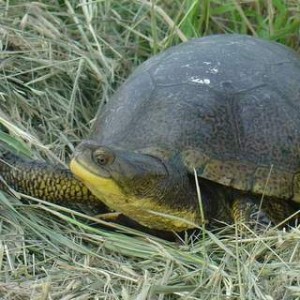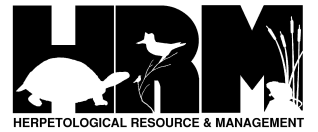Blanding’s Turtle
Overview:
Scientific Name: Emydoidea blandingii
Size: 6 – 10.8” (adult carapace length)
Status: Vulnerable and generally in decline at periphery of range. Destruction and degradation of wetlands and adjacent uplands has led to local extirpation in many areas, though this species can be relatively common where suitable habitat exists.

Habitat:
Shallow, weedy waters such as ponds, marshes, swamps, and lake inlets and coves. Sometimes found in rivers but mainly active in backwaters, embayments, and sloughs. Terrestrial movement is common in the spring mating period.
Adult Coloration:
Carapace black or brown, often marked with highly variable pattern of tan or yellowish spots or streaks. Plastron yellowish, with dark blotch at outer rear edge of each scute. Rarely, dark color may cover most or all of the plastron. Top and sides of head black, brown, or olive, with yellowish or brownish spots or mottling, while chin, throat, and lower neck are bright yellow.
Adult Characteristics:
Moderately high, domed carapace is elongate and quite smooth, without keels or sculpturing. Plastron usually with well-defined annuli and a shallow V-shaped notch at tail. Most adults have hinge between pectoral and abdominal scutes, with flexibility varying greatly. Head flat, with short rounded snout. Neck relatively long. Upper jaw notched at the front, giving this species a permanent “smile.” Males have a moderately concave plastron and a wide tail.
Juvenile Characteristics:
Gray, brown, or black carapace, 1.2 – 1.4” long, with low keel and sometimes a light spot in the center of each scute. Plastron usually with black central blotch rimmed by yellow or cream color. Tail proportionally longer and thicker than in adult. Often more brightly marked overall than adults and carapace scutes may show distinct growth rings.
Species Confused With:
Wood Turtles have a lower, more sculptured carapace and an unhinged plastron. Spotted Turtles are much smaller and have larger, more rounded spots on the head and carapace and also lack a plastral hinge. Eastern Box Turtle has a hooked (not notched) upper jaw and generally does not have a solid yellow throat and neck.
References:
- Amphibians and Reptiles of the Great Lakes Region by Jim Harding
- Harding, J.H. and J.A. Holman. 1990. Michigan Turtles and Lizards. MSU Cooperative Extension Service and MSU Museum. 96 pp.
- Ruthven, A. G., H. B. T. Gaige, et al. 1912. The herpetology of Michigan, by Alexander B. Ruthven. Crystal Thompson and Helen Thompson; Memoranda towards a bibliography of the archaeology of Michigan, by Harlan I. Smith; prepared under the direction of Alexander G. Ruthven. Lansing, Mich., Wynkoop Hallenbeck Crawford, State Printers.
- Holman, J. A. 2012. The Amphibians and Reptiles of Michigan: A Quaternary and Recent Faunal Adventure. Detroit, Mich., Wayne State University Press.
- Conant, R., and Collins, J. T. 1998. Reptiles and Amphibians: Eastern, Central North America. Houghton Mifflin Harcourt Press.
Credits:
- Jim Harding
